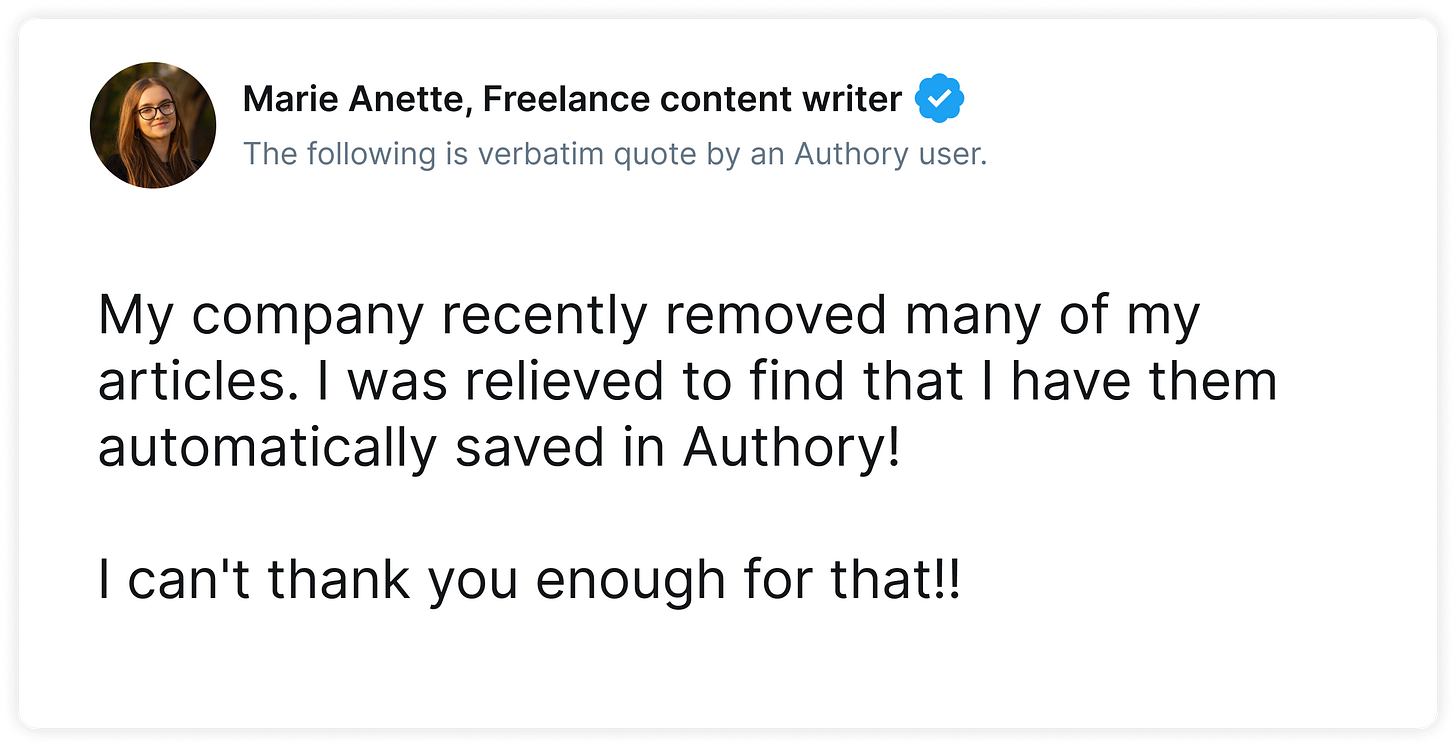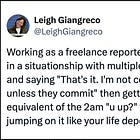What to do if you don't have 'big' bylines
Just remember: A stellar story idea will almost always outweigh a lack of clips.
For all of August, take 25% off a yearly subscription to FWT! With a paid sub, you’ll get an additional newsletter every week, 50% off all workshops and Zoom events, access to the all previous paid posts, invitations to subscriber-only events, and more. Click here to get your discount!
Hello friends, and welcome to the final week of Intro to Freelancing Month! And what a month it’s been, from the basics of getting started to becoming the kind of freelancer that editors text assignments to. I truly hope you’ve gotten something out of this month’s editions. Thursday is the final newsletter — it’s a lovely little send-off to our theme — then next month we’re back to our regularly scheduled programming.
So! Today we’re tackling the single most common question I’ve gotten in the years I’ve been running FWT: What do I do if I don’t have a lot of clips/clips in major outlets/impressive bylines/etc.?
In working directly with thousands of freelancers, both here and in my previous jobs, I’ve spent more time talking writers down from this ledge of anxiety than on any other topic. And not for nothing! This is a perfectly valid thought! We all have this anxiety! It plays into our collective impostor syndrome — as we all know, a regular feature of the freelance life — and sometimes it makes us intimidate ourselves out of pitching those major publications.
Friends, let me put you at ease: Clips definitely matter, but less than you probably think. Let’s get into it.
Zoom workshop alert! Want to get those big bylines? On September 18, I’m hosting a workshop focused on writing a perfect pitch that editors will actually read — and commission. This will cover structure and format, what must be in a pitch, how much pre-reporting you should do, how to find editors to pitch, and so much more. Click here to register. (Paid subscribers get 50% off tickets!)
First of all, do editors really care that much?
In a word: yes. In many words ... here’s what you may not realize about editors and clips.
Yes, clips do matter, editors do care, and we do read them when you pitch us. But it’s a lot more nuanced than just, Is this byline in The New York Times or a hyperlocal blog? Most important, a good clip is a good clip, regardless of where it’s published. But there’s a lot more to it.
For example, I’ve had first drafts come in that take weeks to edit and refine, and my fingerprints are all over them. But I’ve also had drafts come in that are pristine and take a comparatively tiny amount of time to get in shape. Good editors will do everything possible to preserve the original voice, style, intent, and essence of the writer, but sometimes you do get a story that you end up significantly rewriting. It happens to us all, and it’s part of the process. (Remember, though, that you and the editor will always have the same goal in mind, which is to make your story the best version of itself it can be.)
But an outsider to that process sees only the final, published version, with no insight into what it took to get to that version. Editors know this, so we take it into account. To be clear, all credit goes to the writer — it is their byline, after all — but editors have no idea if you filed a story that had to be fully rewritten or if it took just a light touch.
Don’t get me wrong here: At the end of the day, the writer earned that byline, and it is theirs, solely and completely. Don’t let your takeaway here be that I think editors do all the work — I don’t, and I know the process from both sides. I’ve filed countless stories that were directionless or needed a major rewrite (or both!)! Everyone needs an editor.
Sponsored: Never lose your clips again to shuttered websites
Imagine losing years of articles because a site shut down. What would you do if all your work samples disappeared?
With Authory, that’s a nightmare you’ll never have to face. Authory automatically creates a portfolio that backs up everything you’ve ever written and will write, so your work is always safe.
That’s right: Authory finds and backs up all your past work and saves every new piece you publish, no matter where.
Join thousands of writers who already trust Authory to protect their work and never lose a piece again.
Okay, sure. But what if I really don’t have any major clips? Or any clips at all?
That can be okay! It’s not the pitch-killer a lot of freelancers think it is. You have the clips you have, so just send editors your best stuff, no matter where it was published. Is a Los Angeles Times byline better than a local blog? Sure, but you don’t need me to tell you that. But if your best stuff was published in that local blog, don’t discount it — those may be the clips that let you put your best foot forward. Truly, the quality of the story matters so much more than where it was published.
As for what to do if you don’t have any clips at all — well, gotta start somewhere. So just keep pitching! You can mention it, but don’t dwell on it; just something like, I know I don’t have a huge portfolio yet, but I think this story idea is strong enough that I couldn’t not pitch it, or something along those lines. Keep it simple. You’d be surprised at how many editors will take a chance on a less-experienced writer when they have a great idea. We take on those writers knowing the story will probably take more time and energy, but if we believe in the story, that’s time and energy well spent. One of the great joys of being an editor is discovering and developing new writers, so why shouldn’t you be one of them?
That’s all well and good, but what do I actually do about it?
Right, so. Attendees of my Zoom pitching workshops (like the one coming up in September) have long heard me say that the only way to get major bylines is to get major bylines. Don’t intimidate yourself out of swinging for the fences and pitching top outlets. If someone is going to say no to your idea, let it be the editor; don’t say no to yourself.
In truth, that’s kind of it. Again, you have the clips you have, so just include the stuff that best represents you as a writer and journalist. Editors are very willing to take a chance on someone without the “right” clips if they come with a fantastic idea.
What clips should I include, anyway?
Whichever clips best show off your abilities! With every pitch, you want to include three or four specific clips that speak to who you are as a journalist and what you’re capable of, along with a website or portfolio if the editor wants to dive deeper. We’re going to look it up anyway, so might as well just put the link in the pitch itself. (And, yes, a website/portfolio is one of the few mandatory things every freelancer needs no matter what.)
So you’re saying I should just pitch the big league-outlets whenever I want? Even if I don’t have big league-bylines?
Basically, yep!
This whole post is really just a very long of saying way: A great story idea always will almost always outweigh a lack of “big” bylines. You could have a portfolio chock full of Vanity Fair and Washington Post clips, but bylines won’t sell a story idea. That part is up to you.
Oh, a few other things …
• I offer one-on-one coaching! Need help developing an idea or sharpening one you already have? Want a seasoned eye on a pitch you’re kicking around? Interested in talking about careers and building your freelance business? Maybe just want an edit on a story draft? I’ve got you covered! Click below to book a one-on-one coaching session to talk about pitches, story ideas and development, editing, careers, or anything else you might need help with!
• Get a pitch commissioned recently? I want to see it! I’d love to feature you and your #pitchesthatsold in an upcoming series examining great pitches that resulted in stories. Let’s see ’em!
• More from Intro to Freelancing Month:










